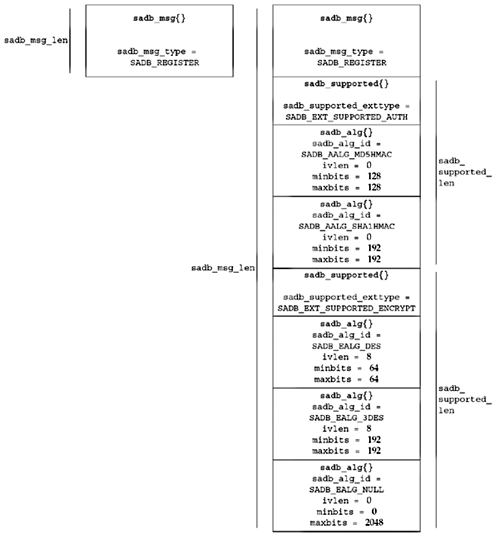19.5 Dynamically Maintaining SAs
For greater security, periodic rekeying is
required. This is usually performed by a protocol such as IKE (RFC
2409 [Harkins and Carrel 1998]).
As of this writing, the IETF IPsec working group
is working on a replacement for IKE.
To learn when an SA is required between a new
pair of hosts, a daemon registers itself with the kernel using the
SADB_REGISTER message, specifying the type of SA it can
handle in the sadb_msg_satype field from the values in
Figure 19.3. If a
daemon can handle multiple SA types, it sends multiple
SADB_REGISTER messages, each registering a single type. In
its SADB_REGISTER reply message, the kernel includes a
supported algorithms extension, indicating what encryption and/or
authentication mechanisms are supported with what key lengths. The
supported algorithms extension is described by an
sadb_supported structure, shown in Figure 19.13; it simply contains a series of
encryption or authentication algorithm descriptions in
sadb_alg structures following the extension header.
Figure 19.13
Supported algorithms extension.
struct sadb_supported {
u_int16_t sadb_supported_len; /* length of extension + algorithms / 8 */
u_int16_t sadb_supported_exttype; /* SADB_EXT_SUPPORTED_{AUTH, ENCRYPT} */
u_int32_t sadb_supported_reserved; /* reserved for future expansion */
};
/* followed by algorithm list */
struct sadb_alg {
u_int8_t sadb_alg_id; /* algorithm ID from Figure 19.8 */
u_int8_t sadb_alg_ivlen; /* IV length, or zero */
u_int16_t sadb_alg_minbits; /* minimum key length */
u_int16_t sadb_alg_maxbits; /* maximum key length */
u_int16_t sadb_alg_reserved; /* reserved for future expansion */
};
One sadb_alg structure follows the
sadb_supported extension header for each algorithm
supported by the system. Figure 19.14 shows a possible reply to a message
registering for SA type SADB_SATYPE_ESP.

Our first example program, shown in Figure 19.15, simply registers with
the kernel for a given mechanism and prints the supported
algorithms reply.
Figure 19.15
Program to register on key management socket.
key/register.c
1 void
2 sadb_register(int type)
3 {
4 int s;
5 char buf[4096]; /* XXX */
6 struct sadb_msg msg;
7 int goteof;
8 int mypid;
9 s = Socket(PF_KEY, SOCK_RAW, PF_KEY_V2);
10 mypid = getpid();
11 /* Build and write SADB_REGISTER request */
12 bzero(&msg, sizeof(msg));
13 msg.sadb_msg_version = PF_KEY_V2;
14 msg.sadb_msg_type = SADB_REGISTER;
15 msg.sadb_msg_satype = type;
16 msg.sadb_msg_len = sizeof(msg) / 8;
17 msg.sadb_msg_pid = mypid;
18 printf("Sending message:\n");
19 print_sadb_msg(&msg, sizeof(msg));
20 Write(s, &msg, sizeof(msg));
21 printf("\nReply returned:\n");
22 /* Read and print SADB_REGISTER reply, discarding any others */
23 for ( ; ; ) {
24 int msglen;
25 struct sadb_msg *msgp;
26 msglen = Read(s, &buf, sizeof(buf));
27 msgp = (struct sadb_msg *) &buf;
28 if (msgp->sadb_msg_pid == mypid &&
29 msgp->sadb_msg_type == SADB_REGISTER) {
30 print_sadb_msg(msgp, msglen);
31 break;
32 }
33 }
34 close(s);
35 }
Open PF_KEY socket
1鈥? We
open the PF_KEY socket.
Store PID
10
Since messages will be addressed to us using our PID, we store it
for comparison later.
Create SADB_REGISTER
message
11鈥?7
Just like SADB_DUMP, the SADB_REGISTER message
does not require any extensions. We zero out the message and then
fill in the individual fields needed.
Display and write message to
socket
18鈥?0
We display the message that we're sending using our
print_sadb_msg function, and send the message to the
socket.
Wait for reply
23鈥?3
We read messages from the socket and wait for the reply to our
register message. The reply is addressed to our PID and is a
SADB_REGISTER message. It contains a list of supported
algorithms, which we print with our print_sadb_msg
function.
Example
We run the register program on a system
that supports several more protocols than are described in RFC
2367.
macosx % register -t ah
Sending register message:
SADB Message Register, errno 0, satype IPsec AH, seq 0, pid 20746
Reply returned:
SADB Message Register, errno 0, satype IPsec AH, seq 0, pid 20746
Supported authentication algorithms:
HMAC-MD5 ivlen 0 bits 128-128
HMAC-SHA-1 ivlen 0 bits 160-160
Keyed MD5 ivlen 0 bits 128-128
Keyed SHA-1 ivlen 0 bits 160-160
Null ivlen 0 bits 0-2048
SHA2-256 ivlen 0 bits 256-256
SHA2-384 ivlen 0 bits 384-384
SHA2-512 ivlen 0 bits 512-512
Supported encryption algorithms:
DES-CBC ivlen 8 bits 64-64
3DES-CBC ivlen 8 bits 192-192
Null ivlen 0 bits 0-2048
Blowfish-CBC ivlen 8 bits 40-448
CAST128-CBC ivlen 8 bits 40-128
AES ivlen 16 bits 128-256
When the kernel needs to communicate with a peer
and policy says that an SA is required but one is not available,
the kernel sends an SADB_ACQUIRE message to key management
sockets that have registered the SA type required, containing a
proposal extension describing the kernel's proposed algorithms and
key lengths. The proposal may be a combination of what is supported
by the system and preconfigured policy that limits what is
permitted for this communication. The proposal is a list of
algorithms, key lengths, and lifetimes, in order of preference.
When a key management daemon receives an SADB_ACQUIRE
message, it performs the acts required to choose a key that fits
one of the kernel's proposed combinations, and installs this key in
the kernel. It uses the SADB_GETSPI message to ask the
kernel to select an SPI from a desired range. The kernel's response
to the SADB_GETSPI message includes creating an SA in the
larval state. The daemon then negotiates security parameters with
the remote end using the SPI supplied by the kernel, and uses the
SADB_UPDATE message to complete the SA and cause it to
enter the mature state. Dynamically created SAs generally have both
a soft and a hard lifetime associated with them. When either
lifetime expires, the kernel sends an SADB_EXPIRE message,
indicating whether the soft or hard lifetime has expired. If the
soft lifetime has expired, the SA has entered the dying state,
during which it can still be used but a new SA must be obtained. If
the hard lifetime has expired, the SA has entered the dead state,
in which it is no longer used for security purposes and will be
removed from the SADB.
|